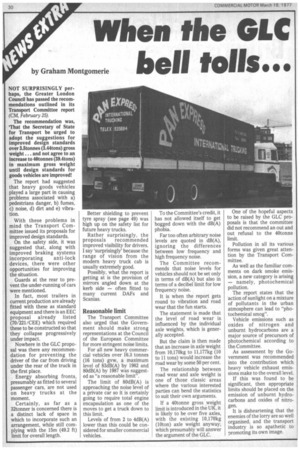When the GLC bell tolls...
Page 32

If you've noticed an error in this article please click here to report it so we can fix it.
by Graham Montgomerie
NOT SURPRISINGLY perhaps, the Greater London Council has passed the recommendations outlined in its Transport Committee report (CM, February 25).
The recommendation was, 'That the Secretary of State for Transport be urged to adopt the suggestions for improved design standards over 3.5tonnes (3.44tons) gross weight ... and not agree to an increase to 40tonnes (39.4tons) in maximum gross weight until design standards for goods vehicles are improved!
The report had suggested that heavy goods vehicles played a large part in causing problems associated with a) pedestrians danger, b) fumes, c) noise, d) dirt and e) vibration.
With these problems in mind the Transport Committee issued its proposals for improved design standards.
On the safety side, it was suggested that, along with improved braking systems incorporating anti-lock devices, there were other opportunities for improving the situation.
Guards at the rear to prevent the under-running of cars were mentioned.
In fact, most trailers in current production are already fitted with these as standard equipment and there is an EEC proposal already listed (70/221 /CEE) which required these to be constructed so that they collapse progressively under impact.
Nowhere in the GLC proposal was there any recommendation for preventing the driver of the car from driving under the rear of the truck in the first place.
Energy absorbing fronts, presumably as fitted to several passenger cars, are not used on heavy trucks at the moment.
Certainly, as far as a 32tonner is concerned there is a distinct lack of space in which to incorporate such an arrangement, while still complying with the 15m (49.2 ft) limit for overall length. Better shielding to prevent tyre spray (see page 49) was high up on the safety list for future heavy trucks.
Rather surprisingly, the proposals recommended improved visibility for drivers. I say 'surprisingly' because the range of vision from the modern heavy truck cab is usually extremely good.
Possibly, what the report is getting at is the provision of mirrors angled down at the kerb side — often fitted to many current DAFs and Scanias.
Reasonable limit
The Transport Committee also urged that the Government should make strong representations at the Council of the European Committee for more stringent noise limits.
For all new heavy commercial vehicles over 16.3 tonnes (16 tons) gvw, a maximum level of 83dB(A) by 1982 and 80dB(A) by 1987 was suggested as "a reasonable limit".
The limit of 80dB(A) is approaching the noise level of a private car so it is certainly going to require total engine encapsulation as one of the moves to get a truck down to this limit.
Levels of from 2 to 4dB(A) lower than this could be considered for smaller commercial vehicles. To the Committee's credit, it has not allowed itself to get bogged down with the dB(A) phobia.
Far too often arbitrary noise levels are quoted in dB(A), ignoring the differences between low frequency and high frequency noise.
The Committee recommends that noise levels for vehicles should not be set only in terms of dB(A) but also in terms of a decibel limit for low frequency noise.
It is when the report gets round to vibration and road wear that the fun starts.
The statement is made that the level of road wear is influenced by the individual axle weights, which is generally accepted.
But the claim is then made that an increase in axle weight from 10,170kg to 11,177kg (10 to 11 tons) would increase the road wear by some 50 per cent.
The relationship between road wear and axle weight is one of those classic areas where the various interested parties can bend the statistics to suit their own arguments.
If a 40tonne gross weight limit is introduced in the UK, it is likely to be over five axles, with the existing 10,170kg (10ton) axle weight anyway, which presumably will answer the argument of the GLC. One of the hopeful aspects to be raised by the GLC proposals is that the committee did not recommend an out and out refusal to the 40tonne limit.
Pollution in all its various forms was given great attention by the Transport Committee.
As well as the familiar comments on dark smoke emission, a new category is arising — namely, photochemical pollution.
The report states that the action of sunlight on a mixture of pollutants in the urban atmosphere can lead to "photochemical smog".
Vehicle emissions such as oxides of nitrogen and unburnt hydrocarbons are a major source of precursors of photochemical according to the Committee.
As assessment by the Government was recommended into the contribution which heavy vehicle exhaust emissions make to the overall level.
If this was found to be significant, then appropriate limits should be placed on the emission of unburnt hydrocarbons and oxides of nitrogen.
It is disheartening that the enemies of the lorry are so well organised, and the transport industry is so apathetic to promoting its own image.




























































































































